
Roudebush Farm is a historic farmstead located southeast of Harrison in northwestern Hamilton County, Ohio, United States. It was established in the 1850s with the construction of a small frame residence. This building, the original farmhouse, was built just one story tall and composed of two rooms. The builder was the farm's namesake, Hammand Hersh Roudebush.

The John Scott Farm is a historic farmstead near the community of Shandon, Ohio, United States. Established in the nineteenth century and still in operation in the twenty-first, the farmstead has been named a historic site because of its traditionally built agricultural structures.
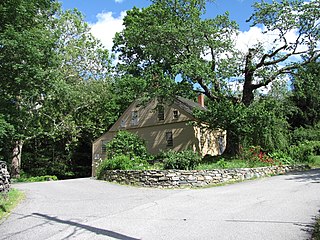
The Freegrace Marble Farm Historic District encompasses a historic farmstead in Sutton, Massachusetts. Although most of its buildings date to the 19th century, the farm has retained the form of a typical 18th-century farm, including a substantial portion of the land granted in 1717 to Freegrace Marble, one of Sutton's earliest colonial settlers. The property was listed on the National Register of Historic Places in 1989.

The Vanmeter Stone House and Outbuildings are a historic farmstead located near Piketon in rural Pike County, Ohio, United States. Established in the early 19th century, the farm has been operated for nearly two centuries by the same family, including a prominent politician. Its inhabitants have pioneered forestry in the region and preserved the original buildings to such an extent that they have been named a historic site.

Stephenson–Campbell House, also known as the Stephenson–Campbell Property and the Stephenson Log House, is a historic site in Cecil, Pennsylvania containing four contributing buildings. Included are a 1778 log house, a 1929 Sears and Roebuck Company mail order bungalow style house, a 1929 spring house, and a 1928 garage. The log house is 16 feet by 34 feet, with several additions totaling about 1360 square feet. The log house is one of the few pre-1780 log houses still standing in Western Pennsylvania, and the only known example of a single story private home still extant in the area.

The Goll Homestead is a historic farm complex in far western Fulton County, Ohio, United States. Located in German Township northwest of Archbold, the farm has been declared a historic site because of its role in the region's settlement.

The James and Sophia Clemens Farmstead is a historic farm in far western Darke County, Ohio, United States. Located at 467 Stingley Road, little more than 1 mile (1.6 km) from the Indiana border, it is among the oldest extant buildings that remain from a small community of free blacks founded before the Civil War.
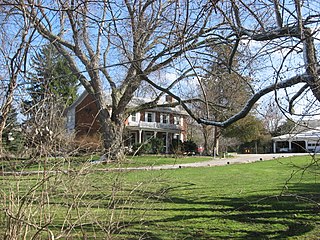
The Griffith Breese Farm is a historic farmstead in southern Allen County, Ohio, United States. Established in 1840, the farm is one of the oldest white settlements in a formerly Native American area of northwestern Ohio, and it has been designated a historic site because of its unusually good degree of preservation.
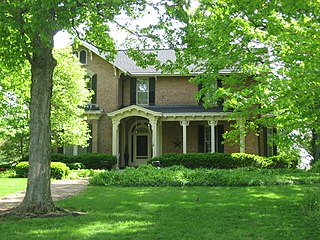
Elmwood Place is a historic farmstead in the southwestern corner of Union County, Ohio, United States. Located along State Route 161 near the community of Irwin, the farmstead comprises six different buildings spread out over an area of 9 acres (3.6 ha).
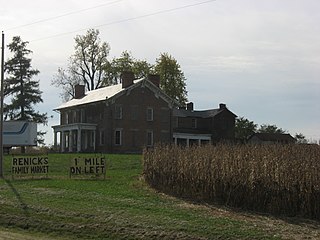
The Renick Farm is a historic farmstead located along U.S. Route 23 near the village of South Bloomfield in northern Pickaway County, Ohio, United States. Composed of six buildings dating back to 1830, the farmstead has been designated a historic site because of its unusually well-preserved architecture.

Bellevue is a historic farmhouse located near the village of Kingston in southern Pickaway County, Ohio, United States. Built of brick on a stone foundation, it was the home of leading early Ohio politician Renick Dunlap.

Applethorpe Farm is a historic farmstead in northeastern Ross County, Ohio, United States. Located along Whissler Road north of the unincorporated community of Hallsville, it was established by the family of John Buchwalter in the early years of the nineteenth century. Among the region's earliest settlers, the Buchwalters erected a large log building soon after taking possession of the property. As the years passed, the farm acquired the name of "Applethorpe" because its grounds included the first apple orchard in Ross County.

The Franklin Harris Farmstead is a historic farm complex located outside the village of Salem in Columbiana County, Ohio, United States. Once home to a prominent former soldier, the farmstead includes a high-style farmhouse from the 1890s, and it has been named a historic site.

Redlands is a historic farmhouse near the city of Circleville in the south-central part of the U.S. state of Ohio. A grand home built in the middle of the 19th century, it has been named a historic site.

The Gill–Morris Farm is a historic farmstead near the city of Circleville in Pickaway County, Ohio, United States. Established in the early nineteenth century, it has been named a historic site.
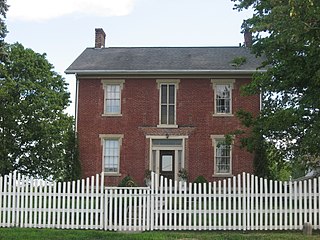
The William Baumgardner Farm is a historic farmstead located near New Carlisle in Miami County, Ohio, United States. Constructed in 1857, the site remains typical of period farmsteads, and it has been named a historic site.

The Wheeler Family Farmstead is a historic farm complex at 817 South Main Street in Great Barrington, Massachusetts. The farmhouse has elements dating to the 1730s, including evidence of building methods used by Dutch settlers of the Hudson River valley, and has been successively modified in each of the following centuries, with the last significant work occurring in the 1920s. All of the surviving farm buildings in the complex are at least 90 years old, and some date to the 19th century. The property was listed on the National Register of Historic Places in 2011, and is now the museum and headquarters of the Great Barrington Historical Society.

The Brugjeld–Peterson Family Farmstead District, also known as Lakeside Farm and the Peterson Point Historical Farmstead, is a historic district in rural Emmet County, Iowa, United States, near the town of Wallingford. It was listed on the National Register of Historic Places in 2000.

The John and Marie (Palen) Schrup Farmstead Historic District is a nationally recognized historic district in Dubuque County, Iowa, United States. It was listed on the National Register of Historic Places in 2009. At the time of its nomination it consisted of four resources, which included three contributing buildings and one non-contributing building. The three buildings include a stone house, barn, and well-house. The buildings are typical of those constructed by immigrant families from Luxembourg that settled in Dubuque and nearby Jackson counties. The front part of the house is the oldest structure here and was built when Martin Burkhart owned the property. He sold the farmstead to Casper Burkhart the following year, who then sold it to John and Marie Schrup in 1856. The Schrups were responsible for adding onto the back of the house about the time they bought it and the other two buildings. The dairy farm of 193 acres (78 ha) remained in the family until 1973. Because it was always a modest enterprise, the stone buildings were not torn down and replaced with modern structures as happened on many of the Luxembourgian farms built in the mid-19th century. A wooden shed was built in the early 20th century, and is the non-contributing building. A pole barn was also added to the farmstead and it fell down c. 1995.

The Gregorius and Mary Hanka Farmstead is a historic farmstead in Embarrass Township, Minnesota, United States. It was established by a Finnish immigrant family around 1910 and includes four surviving buildings constructed with traditional Finnish log architecture. The farm was listed as a historic district on the National Register of Historic Places in 1990 for its state-level significance in the themes of agriculture, architecture, and European ethnic heritage. It was nominated for reflecting the successful conversion of St. Louis County's cutover forests into productive agricultural land by Finnish immigrants, and their use of traditional log architecture.























